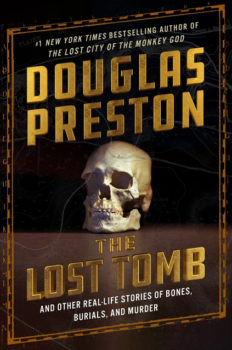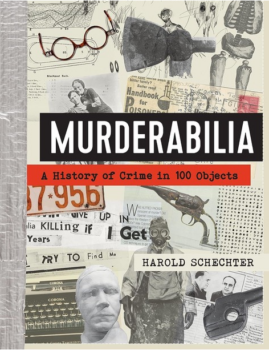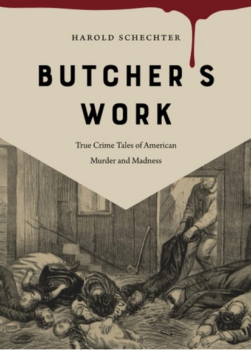Stranger Than Fiction
February 2024
Storied Crimes
by Dean Jobb
 “A love of stories is embedded in our very genes,” contends author and science writer Douglas Preston. “Stories tell us who we are . . . they tell of real people engaged in dramatic events, experiencing danger and crisis, pushed to the limit—tales full of tension, excitement, good and evil, heroism and perfidy.” This month, reviews of three collections of stories that feed our hardwired fascination with real-life crimes.
“A love of stories is embedded in our very genes,” contends author and science writer Douglas Preston. “Stories tell us who we are . . . they tell of real people engaged in dramatic events, experiencing danger and crisis, pushed to the limit—tales full of tension, excitement, good and evil, heroism and perfidy.” This month, reviews of three collections of stories that feed our hardwired fascination with real-life crimes.
Preston is first up, with tales of archeological digs, treasure hunts, controversial discoveries from the time of the dinosaurs, and murders ancient and modern. The 13 stories in The Lost Tomb: And Other Real-Life Stories of Bones, Burials, and Murder (Grand Central Publishing) were previously published in The New Yorker, The Atlantic, Wired and other major magazines over the past 25 years, and a brief note has been added to update each one.
For true crime fans, there’s Preston’s investigation of the Monster of Florence, a sadistic—and still unidentified—serial killer who preyed on young couples in the countryside near the Italian city between 1974 and 1985. He also explores the internet trolls who waged an ugly, vindictive campaign of social-media abuse on Amanda Knox, the American student ultimately cleared of the 2007 murder of her roommate in Perugia. Even his attempt to track down a childhood friend he had not seen since the 1960s leads him to a shocking crime—a Google search reveals his friend died in 2011, the victim of murder.
Other crimes and mysteries he explores occurred centuries ago. Hundreds of skeletons and scattered bones were found at a remote lake in the Himalayas in 1942, and carbon-dating found some had been there for more than 1,300 years. Were they pilgrims who perished in a blizzard or violent hailstorm, or travelers butchered by bandits? And why did DNA testing show that many of the victims were of Greek ancestry and some 5,000 kilometres from home? The discovery of broken up and scorched human bones in the deserts of the southwestern United States offers another mystery. This evidence that an early tribe likely practiced cannibalism takes Preston into the midst of a scientific controversy and a centuries-old cold case.
There are frauds, real or suspected, as well. Preston makes a convincing case that archeologist Frank Hibben, a globe-trotting adventurer who could have been the model for the character Indiana Jones, planted artifacts in a New Mexico cave in the 1940s to claim the discovery of a previously unknown prehistoric race. He tracks down a skilled American craftsman who passed off replicas of ancient, flaked stone spearheads as the real thing, fooling experts and collectors in a con that raked in tens of thousands of dollars.
The collection includes a 1988 piece Preston published in Smithsonian Magazine on the mysterious “Money Pit” on Nova Scotia’s Oak Island, long before the suspected hiding place for pirate treasure became the star of a reality television series. Preston, best-selling author of Lost City of the Monkey God, also writes detective novels—some with plots based on mysteries and crimes he has chronicled as a journalist—and each of these stories is as immersive and unputdownable as any fictional tale. As fellow best-selling author and New Yorker writer David Grann notes in the foreword, “Preston has an unerring sense of suspense, of how to hold the reader in his grip.”
 True crime expert Harold Schechter, like Preston, is fascinated with artifacts. When the body of a murdered Kentucky woman named Pearl Bryan was found in an apple orchard in 1896, people thronged to the scene in search of souvenirs. These “relic hunters,” as one journalist described them, attacked a bush near her corpse, “breaking off branches upon which blood could be seen.” Leaves, stones, and even lumps of clay—“anything that had a blood stain upon it”—was carted off. “In the days before police learned to cordon off crime scenes,” notes Schechter, “souvenir hunters swarmed over the sites of sensational murders, carrying off every scrap of potentially important evidence.”
True crime expert Harold Schechter, like Preston, is fascinated with artifacts. When the body of a murdered Kentucky woman named Pearl Bryan was found in an apple orchard in 1896, people thronged to the scene in search of souvenirs. These “relic hunters,” as one journalist described them, attacked a bush near her corpse, “breaking off branches upon which blood could be seen.” Leaves, stones, and even lumps of clay—“anything that had a blood stain upon it”—was carted off. “In the days before police learned to cordon off crime scenes,” notes Schechter, “souvenir hunters swarmed over the sites of sensational murders, carrying off every scrap of potentially important evidence.”
Such ghoulish behavior, inconceivable in an era of police tape and protective-suited forensic technicians, proves that our current infatuation with all things true crime has deep roots. While the curious no longer plunder crime scenes, there’s still plenty of morbid interest in crime-related memorabilia—a Christmas card signed by serial killer Ted Bundy, for instance, can fetch up to $5,000 at auction. Schechter taps into this appetite for tangible links to unimaginable crimes in Murderabilia: A History of Crime in 100 Objects (Workman Publishing), an illustrated tour of more than two centuries of mayhem and murder.
Schechter, author of more than thirty true crime books, assembles a museum’s worth of ephemera and artifacts. They include Nathan Leopold’s horn-rimmed glasses, found near his victim’s body and the vital clue that linked him—and fellow 1920s thrill-killer Richard Loeb—to Chicago’s Crime of the Century. Here, too, are the Corona typewriter that Ted Kaczynski used to type his Unabomber manifesto, the ladder Bruno Hauptmann built to kidnap the infant son of famed aviator Charles Lindbergh in 1932, and the Ford sedan Bonnie and Clyde were driving when a posse ambushed and killed them two years later (the bullet-riddled car became an amusement-park attraction). An assortment of knives, guns, and other murder weapons are featured, along with lurid pamphlets, artists’ depictions of crimes, and even sheet music that records the suffering of victims and the depravity of their killers.
The collection, like similar “history in 100 objects” titles available on a variety of subjects, offers a new way to explore the history of true crime and its impact on popular culture. Cheap publications that were mass-produced to feed the public’s appetite for details of major crimes, Schechter notes, are the ancestors of today’s true crime podcasts and TV documentaries. While most of the crimes were committed in the U.S., the author also draws on infamous murders in Britain and France and as far afield as Canada and Australia. And some of the objects are cringe-worthy, among them a pocketbook made from the tanned skin of an executed murderer, the battered shovel the nefarious H.H. Holmes used to bury two of his victims, and the rubber gloves a killer used to dispose of corpses in an acid bath.
 Schechter takes a deeper dive into four crimes of the nineteenth and early twentieth centuries in Butcher’s Work: True Crime Tales of American Murder and Madness (University of Iowa Press). It’s a collection of novella-length accounts of murderers who, while little-known today, were sensations in their time. “Why certain psychopaths have attained near-mythic status while other once notorious killers, guilty of equally horrific crimes, have been completely forgotten,” Schechter writes, “is a question that has intrigued me for years.” Key factors that determine who’s remembered and who’s forgotten, he asserts, are whether a killer embodies “the darkest fears and forbidden dreams of an era” or was a seemingly rational person who nevertheless commits “acts of consummate evil.”
Schechter takes a deeper dive into four crimes of the nineteenth and early twentieth centuries in Butcher’s Work: True Crime Tales of American Murder and Madness (University of Iowa Press). It’s a collection of novella-length accounts of murderers who, while little-known today, were sensations in their time. “Why certain psychopaths have attained near-mythic status while other once notorious killers, guilty of equally horrific crimes, have been completely forgotten,” Schechter writes, “is a question that has intrigued me for years.” Key factors that determine who’s remembered and who’s forgotten, he asserts, are whether a killer embodies “the darkest fears and forbidden dreams of an era” or was a seemingly rational person who nevertheless commits “acts of consummate evil.”
Among the overlooked killers he rescues from “near oblivion” are Anton Probst, a German immigrant, drifter, and lowlife who made a good living during the Civil War as a “bounty-jumper” who pocketed bonuses to enlist, skipped town, and repeated the scam. When the war ended he wound up in the Philadelphia area, where he worked as a farmhand for the Deering family. He lasted only three weeks, long enough to discover that his employer, a cattle dealer, kept lots of cash on the farm. Probst returned in February 1866, found an axe, and systematically hacked to death the Deerings, four of their five children, a teenaged employee, and a visiting relative.
His trial and conviction for the “Great Octo-Homicide,” as one newspaper dubbed it, horrified a nation still reeling from the carnage of the war. At first, Probst admitted only to killing his fellow farmhand and claimed an accomplice had lured the other victims to a barn, one by one, and slaughtered them. His confession before his execution, however, provides a chilling example of an ordinary person capable of “acts of consummate evil.” All he wanted, he claimed, was Deering’s money. Unable to sneak into the farmhouse to steal it, he said matter-of-factly, he “formed the design of killing the entire family.” Once his plan was accomplished, he ransacked the house, gathered cash and some valuables, discarded his bloodstained garments, changed into Deering’s clothes, and headed into Philadelphia to spend his loot on booze and women. The police caught up to him within days.
Johann Hoch is no longer a household name, either, but during the Gilded Age he courted, married, and murdered a succession of women for their money in Chicago and other cities, sometimes transforming from suitor to killer in the span of only a few days. He slowly poisoned them and stayed at their bedsides, posing as a caring, dutiful husband as he secretly administered the final, fatal doses. He married at least twenty-nine women, murdered at least nine of them, and abandoned others who became suspicious or refused to sign over their savings. The press nicknamed him “The Modern Bluebeard” and “The Man of Many Wives.” Arrested in 1905, he was convicted of one murder and that was enough to send him to the gallows the following year. Hoch maintained his innocence until the end, admitting only to being “a bigamist and a very wicked man.”
Two more killers round out this collection. Lydia Sherman, a serial poisoner who started her killing spree in 1860s New York City, used arsenic to unburden herself of three husbands and six of her own children. And in Chicago in 1920, First World War veteran Carl Wanderer hatched a plot to rid himself of his pregnant wife. He hired a vagrant to stage a mock mugging. Wanderer claimed the mugger fatally shot his wife before he could pull his own gun and kill her assailant, and was hailed as a hero until his story unraveled and he confessed to killing both of them. He expressed no remorse for the crime, which had been engineered so he could marry a younger woman. His wartime experience, he explained coolly, “taught me not to mind killing.” Schechter employs fast-paced writing and keen insights to bring each of these well-researched stories to life, and even throws in a reference to a couple of macabre items of murderabilia: Anton Probst’s skull and the bones of his right arm wound up on display as part of a New York museum’s collection of medical curiosities.
———
Dean Jobb’s new book, A Gentleman and a Thief: The Daring Jewel Heists of a Jazz Age Rogue (Algonquin Books), will be released in June. It’s the incredible true story of Arthur Barry, who charmed the elite of 1920s New York while planning some of the most brazen jewel thefts in history. For more on this and his other true crime books, find him at deanjobb.com.
Copyright © 2024 Dean Jobb
